|
Longing for Home
by Bob Brooke
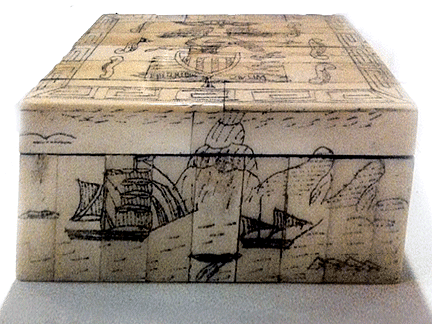 Remember
me when far away Remember
me when far away
From thee on the stormy sea.
For whatever course I'm steering
My heart still points to thee.
And so the inscription reads on a scrimshaw box made by a whaleman for
his wife in the 1830s. Whalemen decorated busks for their sweetheart’s
bodice, carved and decorated pie crimpers, inspired by vision of
homemade pies, and engraved sperm whale teeth with whatever captured
their imagination. Scrimshaw became the pastime of lonely and often
dispirited seamen far from home.
The need for whale blubber and oil fueled the explosion of the whaling
industry in mid-18th-century America. It was discovered that the fat
could be boiled down to make whale oil, a substance that burns with a
bright, white light and produces less smoke, odour or flicker than the
beeswax or animal tallow that had lit houses for previous centuries.
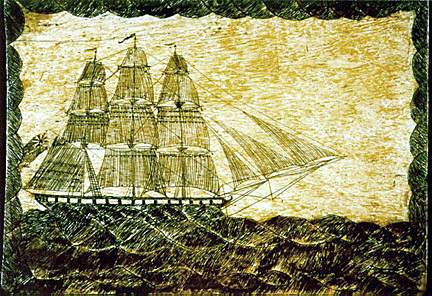 Young,
fit men from America took to the seas by the thousands, for months and
even years at a time to meet the demand. Life aboard was hard; dangerous
in storms and deadly during the frenzy of a whale chase and kill.
Equally grim was the work of killing the whale then boiling down the
carcass into oil. Aside from the toil, the passages were terribly dull,
with weeks and weeks of inactivity while the crew searched the seas for
whales. Young,
fit men from America took to the seas by the thousands, for months and
even years at a time to meet the demand. Life aboard was hard; dangerous
in storms and deadly during the frenzy of a whale chase and kill.
Equally grim was the work of killing the whale then boiling down the
carcass into oil. Aside from the toil, the passages were terribly dull,
with weeks and weeks of inactivity while the crew searched the seas for
whales.
It’s understandable that the whalemen’s minds turned to home during
these long hours. They would have yearned for comfort and security and
the loved ones they had left behind. It’s hard for us to imagine the
intensity of their longing.
Their farewells must have been unimaginably hard; a life at sea had an
uncertain outcome. It would be difficult for them to estimate how long
they would be gone or be confident that they would indeed ever return
from the sea.
During these times some sailors took to modeling and crafting the
by-products of their trade into keepsakes to give to people at home.
Sometimes they were purely decorative: whales’ teeth carved with images
of home or a sweetheart left behind; or large shells pierced and
decorated in filigree. But more often, they were domestic items made
with their womenfolk back home, such as sewing tools, thimbles, needle
cases and yarn winders, or “swifts,”, bodkins, pie crimpers and of
course, corset busks.
The Origin of Scrimshaw
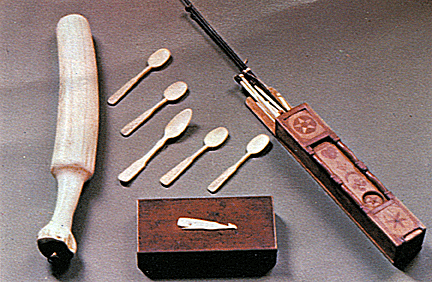 Though
scrimshaw is one of America’s earliest folk arts, the origin of the name
lies in controversy. Some believe it came from “scrimp,” to economize,
and “shaw,” to sand or saw. Others believe the word itself comes from
British slang, "scrimshanker," meaning a time waster. To the contrary,
scrimshanding was a productive use of a whaleman’s time. Originally, it
referred to the production of sailors' hand-tools and practical
implements, such as seam rubbers, fids, belaying pins, and hole pins.
But it eventually came to mean any object carved, etched or fabricated
by whalemen at sea. Beginning in the late 1820s, whaling crewmen
frequently made tools and fittings out of bone and ivory for use aboard
ship, which captains referred to as scrimshaw in their journals. And
whale bone was ideally suited for the task, as it is easy to work and
was plentiful. However, sailors used whatever material they could get,
including walrus tusks which they obtained by trading with indigenous
walrus hunters. Though
scrimshaw is one of America’s earliest folk arts, the origin of the name
lies in controversy. Some believe it came from “scrimp,” to economize,
and “shaw,” to sand or saw. Others believe the word itself comes from
British slang, "scrimshanker," meaning a time waster. To the contrary,
scrimshanding was a productive use of a whaleman’s time. Originally, it
referred to the production of sailors' hand-tools and practical
implements, such as seam rubbers, fids, belaying pins, and hole pins.
But it eventually came to mean any object carved, etched or fabricated
by whalemen at sea. Beginning in the late 1820s, whaling crewmen
frequently made tools and fittings out of bone and ivory for use aboard
ship, which captains referred to as scrimshaw in their journals. And
whale bone was ideally suited for the task, as it is easy to work and
was plentiful. However, sailors used whatever material they could get,
including walrus tusks which they obtained by trading with indigenous
walrus hunters.
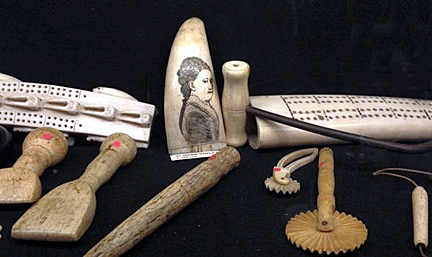
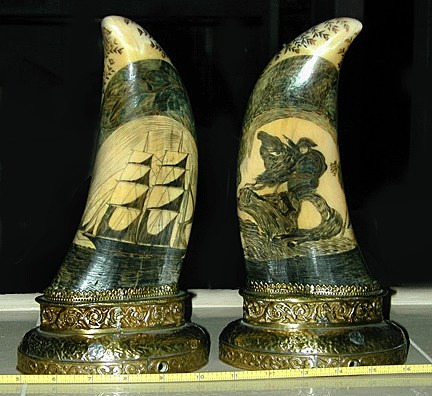 Because
whaling was dangerous, whalers couldn’t work at night. This gave them a
great deal more free time than other sailors. They created scrimshaw to
pass the time and most never signed their work. To scratch the designs
into the ivory, sailors used crude sailing needles, and the movement of
the ship, as well as the skill of the artist, produced drawings of
varying levels of detail and artistry. Originally, they used lampblack,
soot or tobacco juice to make their etched designs more easily seen.
Some brought ink onboard before the voyage. Because
whaling was dangerous, whalers couldn’t work at night. This gave them a
great deal more free time than other sailors. They created scrimshaw to
pass the time and most never signed their work. To scratch the designs
into the ivory, sailors used crude sailing needles, and the movement of
the ship, as well as the skill of the artist, produced drawings of
varying levels of detail and artistry. Originally, they used lampblack,
soot or tobacco juice to make their etched designs more easily seen.
Some brought ink onboard before the voyage.
American whalers gave the art of inscribing and decorating marine items
the name of “scrimshaw” and it was the publication of Herman Melville’s
Moby Dick in 1851 which brought this folk art to the wider world on both
sides of the Atlantic. The author describes the “lively sketches of
whales and whaling scenes, graven by fishermen themselves on sperm whale
teeth or ladies’ busks wrought out of the right whalebone, and other
like skrimshander articles, as the whalemen call the numerous little
ingenious contrivances they elaborately carve out of the rough material
in their hours of ocean leisure.”
Early Scrimshaw
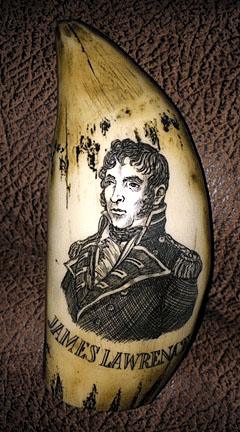 The
earliest known works of incised pictorial scrimshaw date from as early
as 1817, the date of the earliest authenticated pictorial piece of sperm
whale scrimshaw, a whale’s tooth inscribed: "This is the tooth of a
sperm whale that was caught near the Galapagos islands by the crew of
the ship Adam [of London], and made 100 barrels of oil in the year
1817.” The
earliest known works of incised pictorial scrimshaw date from as early
as 1817, the date of the earliest authenticated pictorial piece of sperm
whale scrimshaw, a whale’s tooth inscribed: "This is the tooth of a
sperm whale that was caught near the Galapagos islands by the crew of
the ship Adam [of London], and made 100 barrels of oil in the year
1817.”
But it was Edward Burdett, the first known American scrimshaw artist,
and one of the best, who began scrimshandering around 1824, that made it
into the art form that it is today. Scrimshaw of these early whalemen,
or scrimshanders as they were known, featured nautical motifs—whales,
wharf scenes, battles at sea. Although most whalemen created scrimshaw
as homecoming presents for loved ones, some sold their work in a foreign
ports, if they needed cash.
Though the 1830's and 1840's was the golden age of pictorial scrimshaw,
the genre continued even during the decline of the whaling industry into
last part of the 19th Century. By 1870, N. S. Finney, a native of
Plymouth, Massachusetts, who had been a whaleman in the 1840's, set
himself up in San Francisco and engraved walrus tusks on commission,
becoming the first person to take scrimshandering professional. In most
cases, it remained a shipboard pastime that provided welcome relief from
the alternating hard labor and abject boredom of a whaling voyage.
Tools and Materials Used by Scrimshanders
Scrimshanders used whale and walrus ivory and bone as the basis for
their craft. Both tended to dry out over time, becoming brittle, so it
was best for them to incise while the material was fresh and still
permeated with its natural moisture and oils. Whalemen's
 journals
mention soaking teeth in brine to soften them and preserve their
suppleness if they couldn’t be worked on immediately. To prepare the
surface for incising, scrimshanders removed the natural ridges and
imperfections by scraping with a knife, then sawed off the rough,
irregular root end of the tooth or tusk to f journals
mention soaking teeth in brine to soften them and preserve their
suppleness if they couldn’t be worked on immediately. To prepare the
surface for incising, scrimshanders removed the natural ridges and
imperfections by scraping with a knife, then sawed off the rough,
irregular root end of the tooth or tusk to f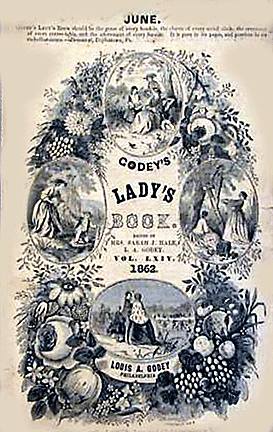 orm
a base. They then smoothed the surface with sharkskin or pumice, then
burnished with it with a cloth. To incise their designs, whalemen
commonly used jackknives, though sometimes they employed sail needles. orm
a base. They then smoothed the surface with sharkskin or pumice, then
burnished with it with a cloth. To incise their designs, whalemen
commonly used jackknives, though sometimes they employed sail needles.
Where did they get the inspiration for their drawings? While they often
traced illustrations in periodicals and books such as Godey’s Lady’s
Book and Leslie’s Illustrated, they also drew inspiration from the
Bible. But, mostly, they drew what they knew best--rowing a whaleboat
across a restless ocean and encountering a ferocious sperm whale. They
also employed catchwords and phrases like “greasy luck to whalers” or “a
dead whale” or “a stove boat.”
Subject Matter
Scrimshanders had no rules and few precedents to govern their choice of
subject matter, but most favored portraits, patriotic subjects, ship
portraits, whaling scenes, naval engagements, and domestic vignettes.
Nostalgic pictures of their own houses often bore a caption like "Home,
sweet home." One whale's tooth displays, on one side, a picture of a
respectably attired wife at home; on the other side an exotic South Sea
girl in sarong. The caption: "To our Wives and Sweethearts. May they
never meet."
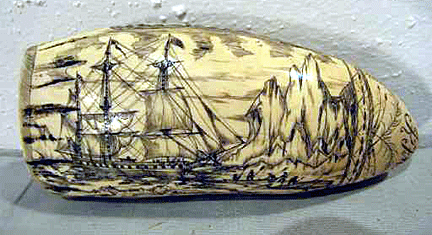
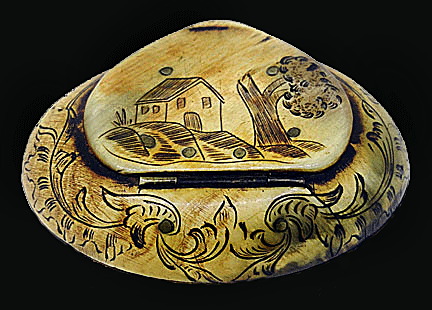 To
copy an illustration, the scrimshander would lay it over the surface of
the ivory or bone, perhaps wetting the paper to make it more pliant, and
prick through it with a sailmaker's needle, leaving a pattern of dots in
the polished surface that could be connected to form a facsimile of the
printed original. Afterwards, he’d rub soot, lampblack or other pigments
mixed with whale-oil over the lines, then wipe it away, leaving the
pigment only in the fine lines. For colored work, a whaleman might use
tobacco juice, colored inks, or vegetable dyes. To
copy an illustration, the scrimshander would lay it over the surface of
the ivory or bone, perhaps wetting the paper to make it more pliant, and
prick through it with a sailmaker's needle, leaving a pattern of dots in
the polished surface that could be connected to form a facsimile of the
printed original. Afterwards, he’d rub soot, lampblack or other pigments
mixed with whale-oil over the lines, then wipe it away, leaving the
pigment only in the fine lines. For colored work, a whaleman might use
tobacco juice, colored inks, or vegetable dyes.
Some of the more common scrimshaw objects included canes; corset busks
and stays, dominoes, doorknobs, pastry crimpers (also known as jagging
wheels), rolling pins, and rings and bracelets. Ditty boxes could be
extremely simple or highly ornate, made entirely of baleen or bone, or a
combination of materials and inlays, sometimes adorned with a carved
human or animal figure.
Scrimshaw Love Tokens
A busk, which was one of the whalers’ commonest love tokens, is a
stiffener slipped lengthways into the front of a lady’s undergarments.
Its purpose was to keep the front of the corset (and its wearer)
straight and upright and prevent any creasing or wrinkling of the fabric
of the dress.
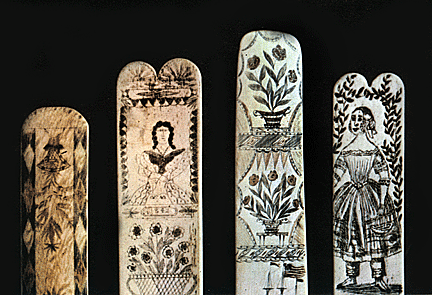
For centuries, busks had been made from wood, bone or ivory, but
whalemen had access to baleen: the flat lengths of stiff keratin (the
material from which horn, hair and fingernails are made) that make up
the filtration system in a whale’s mouth. Baleen had a strength and
plasticity that was perfectly suited to the job. Often it is
misidentified as whale bone as it can be cream in colour, but sometimes
dark, or opaque, a similar range of shades to horn, depending on the
breed of whale from which it came.
Surviving examples are carved and scratched with intertwined hearts,
doves and flowers, images of couples with hoped-for children, churches
that show their intent to marry, or fond memories of their weddings. The
north star signified a hope to be guided safely home.
Wheatsheaves and cornucopia – a metaphor for future fertility, abundance
and wealth – were common. A homestead, often with smoke rising from the
chimney, expressed a longing for the comforts and security of home and
dry land.
Lampblack Pictures
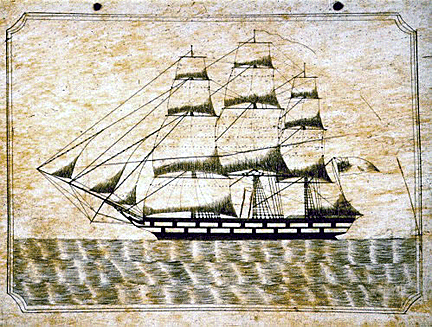 The
whalemen would scratch the words and patterns into the baleen then use
“lampblack,” a sooty oily by-product from the ships’ lamps, as a pigment
to rub into the incisions. Occasionally busks were polychromatic if
other sources of color were available aboard ship, for example green
verdigris deposits from copper or brass, or vegetable dyes from food. The
whalemen would scratch the words and patterns into the baleen then use
“lampblack,” a sooty oily by-product from the ships’ lamps, as a pigment
to rub into the incisions. Occasionally busks were polychromatic if
other sources of color were available aboard ship, for example green
verdigris deposits from copper or brass, or vegetable dyes from food.
Surely none of the intimacy of this item of women’s toiletry would have
been lost on the sailor as he worked on a busk for his sweetheart at
sea. Although distant, the thought that he could make a keepsake that
would be worn inside his loved one’s dress, slipped between her breasts
and close to her heart in his absence, would have been a compelling
thought.
Busks were typically decorated with scenes from their travels, such as
cityscapes, ports and boats, sometimes even depictions of the whale hunt
itself. Many of them are also decorated with touching symbolism and
coded messages of love.
Other Forms of Scrimshaw
Among the most elaborate creations were "architectural" forms—pocketwatch
stands, usually shaped like miniature "grandfather" clocks, a nighttime
resting place for dad's gold timepiece. Sewing boxes, typically built of
wood or bone, often lavishly fitted with drawers, spools for thread,
pincushions, and other accessories, were characteristically ornately
decorated with inlay, finials, fobs, and fixtures of marine ivory, sea
shell, tortoise shell, and silver. A skeletal-bone and or wood-and-bone
birdcage could consume countless months of work at sea. Banjos and
violins with ivory and bone fittings were also in the inventory of the
musically inclined and manually skilled. A yarn winder, known as a
"swift," was probably the most complicated form of scrimshaw.
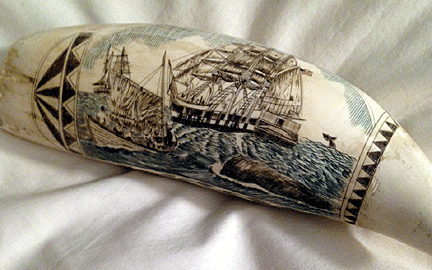
Even though people created scrimshaw since the Revolutionary War, it
didn’t become widely recognized as a collectible until President John F.
Kennedy, an enthusiastic collector, brought scrimshaw to the public eye.
Museums
Nantucket Whaling Museum
- Nantucket, Massachusetts
New Bedford
Whaling Museum, New Bedford, Massachusetts
Sag harbor Whaling
Museum - Sag Harbor, Long Island, New York
Salt Pond Visitors Center - Cape Cod National Seashore.
Massachusetts
Peabody Essex Museum
- Salem, Massachusetts
The
Whaling Museum and Education Center - Cold Spring Harbor, Long
Island, New York.
Read "The
Value of Scrimshaw Soars."
< Back
to Collectibles Archives
Next Article > |
